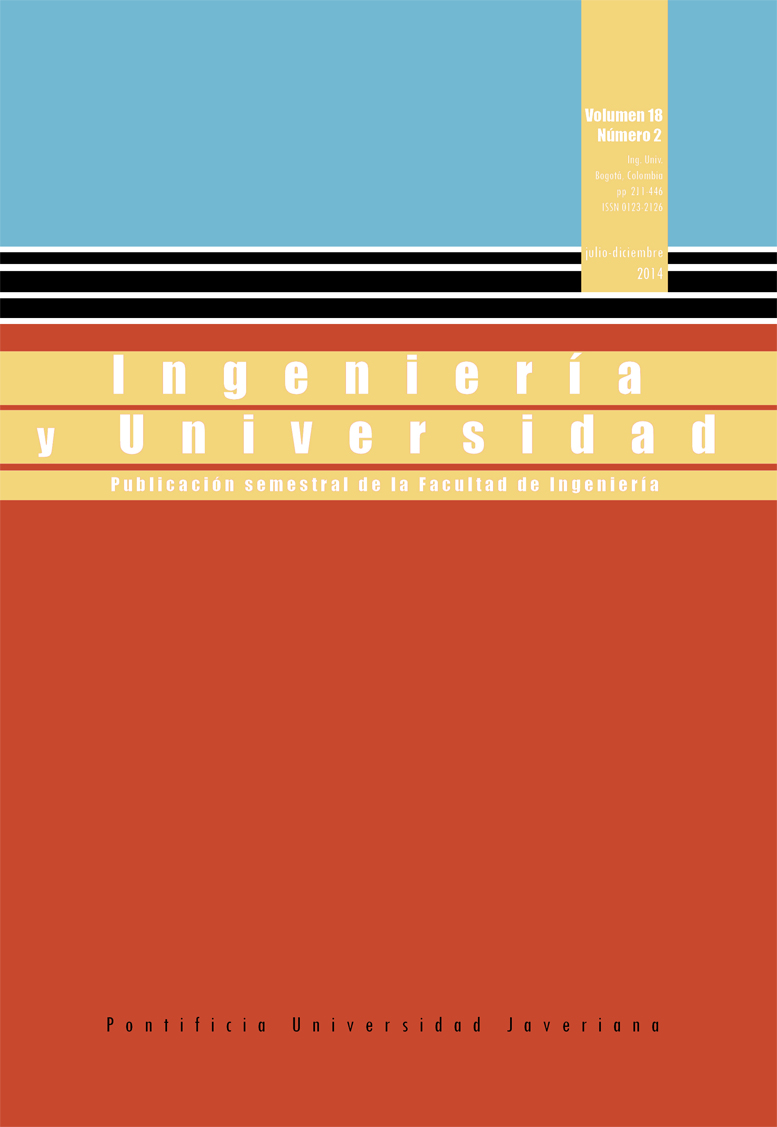Resumen
Este trabajo evalúa la atenuación hídrica de un techo verde productivo mediante tres indicadores: lag-time, coeficiente de escorrentía y porcentaje de retención volumétrica. Se utilizaron dos especies de plantas: una herbácea (Lactuca sativa) y una crucífera (Raphanus sativus). Se registraron ocho eventos de lluvia en cuatro casas del barrio La Isla, en Soacha, Colombia (4° 34’ 22.3”, 74° 10’ 53.5”, 2701 msnm). Se observaron retardos de la escorrentía hasta de 32 minutos, coeficientes equivalentes de escorrentía mínimos hasta de 0,1 y porcentajes de retención volumétrica máximos cercanos al 80 %. Se evaluaron los beneficios hidrológicos de implementar techos verdes comparando la infraestructura de drenaje requerida con techos verdes y sin estos, y calculando sus respectivas probabilidades de inundación en el área de estudio (barrio La Isla, Soacha, Colombia). Se simuló la respuesta del alcantarillado propuesto mediante la metodología de Monte Carlo, y al implementar techos verdes en toda el área de estudio: el coeficiente de escorrentía se distribuyó aleatoriamente, siguiendo una distribución de Kernel correspondiente a los datos registrados en campo. Los resultados obtenidos evidenciaron ahorros cercanos al 22 % y una reducción del 35 % de las probabilidades de inundación.
ABDI, H. and WILLIAMS, L.J. Principal component analysis. Wiley Interdisciplinary Reviews: Computational Statistics. 2010, no. 2, pp. 433-459.
ARSHAM, H. and LOVRIC, M. Bartlett’s test. International Encyclopedia of Statistical Science. 2011, pp. 87-88.
ASTM-D 2321.Standard practice for underground installation of thermoplastic pipe for sewer and other gravity-flow applications. (STANDARD), 2000.
BALLARD, B.W. and KELLAGHER, R. The SUDS Manual. n. p.: Construction Industry Research & Information Association (CIRIA), 2007a.
BALLARD, B.W. and KELLAGHER, R. The SUDS Manual. n. p.: Construction Industry Research & Information Association (CIRIA), 2007b.
BUTLER, D. and DAVIES, J.W. Urban drainage. New York: Taylor & Francis, 2009.
CASSERES, E. Producción de hortalizas. n. p.: Bib. Orton IICA/CATIE, 1980.
CASTLETON, H.F.; STOVIN, V.; BECK, S.B.M. and DAVISON, J.B. Green roofs; building energy savings and the potential for retrofit. Energy and Buildings. 2010, no. 42, pp. 1582-1591.
CHEN, J.; HILL, A.A. and URBANO, L.D. A GIS-based model for urban flood inundation. Journal of Hydrology. 2009, no. 373, pp. 184-192. DOI: 10.1016/j.jhydrol.2009.04.021.
CSQ. Stormwater best management practice handbook. Los Angeles: California Stormwater Quality Association, 2003.
DUNNETT, N.; NAGASE, A.; BOOTH, R. and GRIME, P. Influence of vegetation composition on runoff in two simulated green roof experiments. Urban Ecosyst. 2008, no. 11, pp. 385-398. DOI: 10.1007/s11252-008-0064-9.
DUONG, T. ks: Kernel density estimation and Kernel discriminant analysis for multivariate data in R. Journal of Statistical Software. 2007, vol. 21, no. 7, pp. 1-16.
FORERO-CORTES, C.; DEVIA-CASTILLO, C.; TORRES, A. and MENDEZ-FAJARDO, S. Diseño de ecotechos productivos para poblaciones vulnerables. n. p.: Acodal, 2012.
GETTER, K.L. and ROWE, D.B. The role of extensive green roofs in sustainable development. HortScience. 2006, no. 41, pp. 1276-1285.
GUIDOUM, A.C. kedd: Kernel estimator and bandwidth selection for density and its derivatives [document on line]. R package version 1.0.0, 2013. <http://CRAN.R-project.org/package=kedd>.
HWANG, J.; LAY, S. and LIPPMAN, A. Nonparametric multivariate density estimation: A comparative study. IEEE Transactions on Signal Processing. 1994, vol. 42, no. 10, pp. 2795-2810.
IPO. Contexto Alto de Cazucá (publico). Bogota: IPO, 2004.
JACOBSON, C.R.. Identification and quantification of the hydrological impacts of imperviousness in urban catchments: A review. Journal of Environmental Management. 2011, no. 92, pp. 1438-1448. DOI: 10.1016/j.jenvman.2011.01.018.
KASMIN, H.; STOVIN, V.R. and HATHWAY, E.A. Towards a generic rainfall-runoff model for green roofs. Water Science Technology. 2010, no. 62, pp. 898-905. DOI: 10.2166/wst.2010.352.
LARSON, M.G. Analysis of variance. Circulation. 2008, no. 117, pp. 115-121. DOI: 10.1161/CIRCULATIONAHA.107.654335.
LI, S.; GONG, H.; ZHAO, W. and LIU, J. Research on Beijing urban heat island and PM10 in the air. Education Technology and Training, 2008. and 2008 International Workshop on Geoscience and Remote Sensing. ETT and GRS 2008. International Workshop on. 2008, vol. 2, pp. 133-136. DOI: 10.1109/ETTandGRS.2008.277.
MARSALEK, J. Urban water cycle processes and interactions. New York: Taylor & Francis, 2007.
MENTENS, J., RAES, D. and HERMY, M. Green roofs as a tool for solving the rainwater runoff problem in the urbanized 21st century? Landscape and Urban Planning. 2006, vol. 77, pp. 217-226. DOI: 10.1016/j.landurbplan.2005.02.010.
NEW JERSEY DEPARTMENT OF ENVIRONMENTAL PROTECTION. New Jersey Stormwater Best Management Practices Manual. Trenton, NJ, 2004.
NIEMCZYNOWICZ, J. Urban hydrology and water management – present and future challenges. Urban Water. 1999, vol. 1, pp. 1-14. DOI: 10.1016/S1462-0758(99)00009-6.
OBERNDORFER, E.; LUNDHOLM, J.; BASS, B.; COFFMAN, R.R.; DOSHI, H.; DUNNETT, N.; GAFFIN, S.; KÖHLER, M.; LIU, K.K.Y. and ROWE, B. Green roofs as urban ecosystems: ecological structures, functions, and services. BioScience. 2007, vol. 57, p. 823. DOI: 10.1641/B571005.
PECK, S.W. and CALLAGHAN, C. Green roofs: ecological design and construction. n. p.: Schiffer Pub, 2005.
R DEVELOPMENT CORE TEAM. R: A Language and Environment for Statistical Computing. Vienna, Austria, 2012.
ROSSMAN, L.A. Storm water management model user’s manual. Version 5.0. Cincinnati: n. e., 2010.
SHAPIRO, S.S. and WILK, M.B. An analysis of variance test for normality (complete samples). Biometrika. 1965, vol. 52, no. 3/4, pp. 591-611.
TSYBAKOV, A.B. Introduction to nonparametric estimation. Philadelphia: Springer, 2008.
WERTHMANN, C. Green roof: a case study. New York: Princeton Architectural Press, 2007.
Una vez aceptado un trabajo para publicación la revista podrá disponer de él en toda su extensión, tanto directamente como a través de intermediarios, ya sea de forma impresa o electrónica, para su publicación ya sea en medio impreso o en medio electrónico, en formatos electrónicos de almacenamiento, en sitios de la Internet propios o de cualquier otro editor. Este uso tiene como fin divulgar el trabajo en la comunidad científica y académica nacional e internacional y no persigue fines de lucro. Para ello el autor o los autores le otorgan el permiso correspondiente a la revista para dicha divulgación mediante autorización escrita.
Todos los articulos aceptados para publicación son sometidos a corrección de estilo. Por tanto el autor /los autores autorizan desde ya los cambios sufridos por el artículo en la corrección de estilo.
El autor o los autores conservarán los derechos morales y patrimoniales del artículo.



